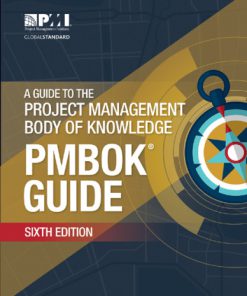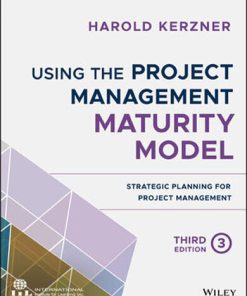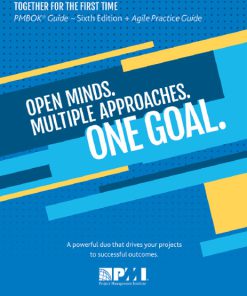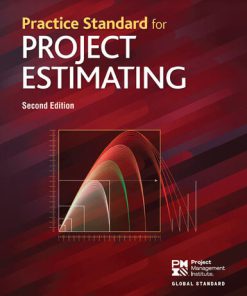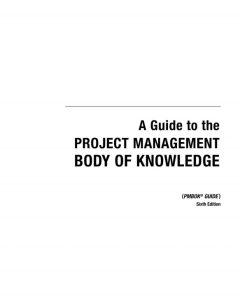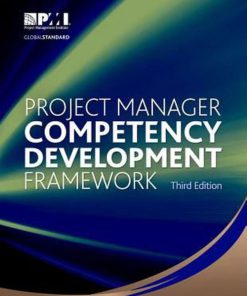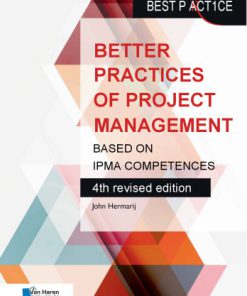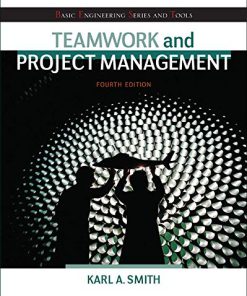Contemporary Project Management 4th Edition by Timothy Kloppenborg, Vittal Anantatmula, Wells Kathryn 1337406457 9781337406451
$50.00 Original price was: $50.00.$25.00Current price is: $25.00.
Contemporary Project Management 4th Edition by Timothy Kloppenborg, Vittal Anantatmula, Wells Kathryn – Ebook PDF Instant Download/DeliveryISBN: 1337406457, 9781337406451
Full download Contemporary Project Management 4th Edition after payment.
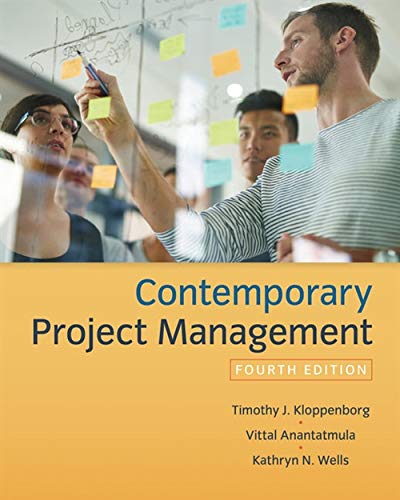
Product details:
ISBN-10 : 1337406457
ISBN-13 : 9781337406451
Author: Timothy Kloppenborg, Vittal Anantatmula, Wells Kathryn
Learn to master the most proven methods in project management as well as exciting new techniques emerging from current industry and today’s most recent research with Kloppenborg’s CONTEMPORARY PROJECT MANAGEMENT, 4E. This edition introduces time-tested manual techniques and progressive automated techniques, all consistent with the latest PMBOK® Guide and standards and integrated with Microsoft® Project 2016. The book’s focused approach is ideal for building strong portfolios that showcase project management skills for future interviews. All content is consistent with the knowledge areas and processes of the 6th edition of the PMBOK® Guide to give you an advantage as you prepare to become a Certified Associate in Project Management (CAPM®) or Certified Project Management Professional (PMP®), if desired.
Contemporary Project Management 4th Table of contents:
Part 1. Organizing Projects
Chapter 1. Introduction to Project Management
1-1. What Is a Project?
1-2. History of Project Management
1-3. How Can Project Work Be Described?
1-3a. Projects versus Operations
1-3b. Soft Skills and Hard Skills
1-3c. Authority and Responsibility
1-3d. Project Life Cycle
1-4. Understanding Projects
1-4a. Project Management Institute
1-4b. Project Management Body of Knowledge (PMBOK®)
1-4c. The PMI Talent Triangle
1-4d. Selecting and Prioritizing Projects
1-4e. Project Goals and Constraints
1-4f. Defining Project Success and Failure
1-4g. Using Microsoft Project to Help Plan and Measure Projects
1-4h. Types of Projects
1-4i. Scalability of Project Tools
1-5. Project Roles
1-5a. Project Executive-Level Roles
1-5b. Project Management-Level Roles
1-5c. Project Associate-Level Roles
1-6. Overview of the Book
1-6a. Part 1: Organizing and Initiating Projects
Part 2: Leading Projects
1-6b. Part 3: Planning Projects
1-6c. Part 4: Performing Projects
PMP/CAPM Study Ideas
Summary
Key Terms Consistent with PMI Standards and Guides
Chapter Review Questions
Discussion Questions
PMBOK® Guide Questions
Section Content
Section Content
Semester Project Instructions
Section Content
References
Chapter 2. Project Selection and Prioritization
2-1. Strategic Planning Process
2-1a. Strategic Analysis
2-1b. Guiding Principles
2-1c. Strategic Objectives
2-1d. Flow-Down Objectives
2-2. Portfolio Management
Portfolio Example
2-2a. Portfolios
2-2b. Programs
2-2c. Projects and Subprojects
2-2d. Assessing an Organization’s Ability to Perform Projects
2-2e. Identifying Potential Projects
2-2f. Using a Cost-Benefit Analysis Model to Select Projects
2-2g. Using a Scoring Model to Select Projects
2-2h. Prioritizing Projects
2-2i. Resourcing Projects
2-3. Securing Projects
2-3a. Identify Potential Project Opportunities
2-3b. Determine Which Opportunities to Pursue
2-3c. Prepare and Submit a Project Proposal
2-3d. Negotiate to Secure the Project
PMP/CAPM Study Ideas
Summary
Key Terms Consistent with PMI Standards and Guides
Chapter Review Questions
Discussion Questions
PMBOK® Guide Questions
Exercises
Section Content
Section Content
Semester Project Instructions
Section Content
References
Chapter 3. Chartering Projects
3-1. What Is a Project Charter?
3-2. Why Is a Project Charter Used?
3-3. When Is a Charter Needed?
3-4. Typical Elements in a Project Charter
3-4a. Title
3-4b. Scope Overview
3-4c. Business Case
3-4d. Background
3-4e. Milestone Schedule with Acceptance Criteria
3-4f. Risks, Assumptions, and Constraints
3-4g. Resource Estimates
3-4h. Stakeholder List
3-4i. Team Operating Principles
3-4j. Lessons Learned
3-4k. Signatures and Commitment
3-5. Constructing a Project Charter
3-5a. Scope Overview and Business Case Instructions
3-5b. Background Instructions
3-5c. Milestone Schedule with Acceptance Criteria Instructions
3-5d. Risks, Assumptions, and Constraints Instructions
3-5e. Resources Needed Instructions
3-5f. Stakeholder List Instructions
3-5g. Team Operating Principles Instructions
3-5h. Lessons Learned Instructions
3-5i. Signatures and Commitment Instructions
3-6. Ratifying the Project Charter
3-7. Starting a Project Using Microsoft Project
3-7a. MS Project 2016 Introduction
3-7b. Setting up Your First Project
3-7c. Define Your Project
3-7d. Create a Milestone Schedule
PMP/CAPM Study Ideas
Summary
Key Terms Consistent with PMI Standards and Guides
Chapter Review Questions
Discussion Questions
PMBOK® Guide Questions
Exercises
Section Content
Section Content
Semester Project Instructions
Section Content
References
Part 2. Leading Projects
Chapter 4. Organizational Capability: Structure, Culture, and Roles
4-1. Types of Organizational Structures
4-1a. Functional
4-1b. Projectized
4-1c. Matrix
4-2. Organizational Culture and Its Impact on Projects
4-2a. Culture of the Parent Organization
4-2b. Project Cultural Norms
4-3. Project Life Cycles
4-3a. Define-Measure-Analyze-Improve-Control (DMAIC) Model
4-3b. Research and Development (R&D) Project Life Cycle Model
4-3c. Construction Project Life Cycle Model
4-3d. Agile Project Life Cycle Model
4-4. Agile Project Management
4-4a. What Is Agile?
4-4b. Why Use Agile?
4-4c. What Is an Agile Mindset?
4-4d. What Are the Key Roles in Agile Projects?
4-4e. How Do You Start an Agile Project?
4-4f. How Do You Continue an Agile Project?
4-4g. What Is Needed for Agile to Be Successful?
4-5. Traditional Project Executive Roles
4-5a. Steering Team
4-5b. Sponsor
4-5c. Customer
4-5d. Chief Projects Officer/Project Management Office
4-6. Traditional Project Management Roles
4-6a. Functional Manager
4-6b. Project Manager
4-6c. Facilitator
4-7. Traditional Project Team Roles
4-7a. Core Team Members
4-7b. Subject Matter Experts
4-8. Role Differences on Agile Projects
PMP/CAPM Study Ideas
Summary
Key Terms Consistent with PMI Standards and Guides
Chapter Review Questions
Discussion Questions
PMBOK® Guide Questions
Exercises
Section Content
Section Content
Semester Project Instructions
Section Content
References
Chapter 5. Leading and Managing Project Teams
5-1. Acquire Project Team
5-1a. Preassignment of Project Team Members
5-1b. Negotiation for Project Team Members
5-1c. On-Boarding Project Team Members
5-2. Develop Project Team
5-2a. Stages of Project Team Development
5-2b. Characteristics of High-Performing Project Teams
5-2c. Assessing Individual Member Capability
5-2d. Assessing Project Team Capability
5-2e. Building Individual and Project Team Capability
5-2f. Establishing Project Team Ground Rules
5-3. Manage Project Team
5-3a. Project Manager Power and Leadership
5-3b. Assessing Performance of Individuals and Project Teams
5-3c. Project Team Management Outcomes
5-4. Relationship Building Within the Core Team
5-5. Managing Project Conflicts
5-5a. Sources of Project Conflict
5-5b. Conflict-Resolution Process and Styles
5-5c. Negotiation
5-6. Communication Needs of Global and Virtual Teams
5-6a. Virtual Teams
5-6b. Cultural Differences
5-6c. Countries and Project Communication Preferences
Summary
Key Terms from the PMBOK® Guide
Chapter Review Questions
Discussion Questions
PMBOK ® Guide Study Tips and Questions
Section Content
References
Section Content
Chapter 6. Stakeholder Analysis and Communication Planning
6-1. Identify Stakeholders
6-1a. Find Stakeholders
6-1b. Analyze Stakeholders
6-1c. Document Stakeholders
6-2. Plan Stakeholder Engagement
6-2a. Creating a Stakeholder Engagement Assessment Matrix
6-2b. Planning to Build Relationships with Stakeholders
6.3. Manage Stakeholder Engagement
6-4. Monitor Stakeholder Engagement
6-5. Plan Communications Management
6-5a. Purposes of a Project Communications Plan
6-5b. Communications Plan Considerations
6-5c. Communications Matrix
6-5d. Manage Project Knowledge
6-6. Manage Communications
6-6a. Determine Project Information Needs
6-6b. Establish Information Retrieval and Distribution System
6-6c. Project Meeting Management
6-6d. Issues Management
PMP/CAPM Study Ideas
Summary
Key Terms Consistent with PMI Standards and Guides
Chapter Review Questions
Discussion Questions
PMBOK® Guide Questions
Section Content
Section Content
Semester Project Instructions
Section Content
References
Part 3. Planning Projects
Chapter 7. Scope Planning
7-1. Plan Scope Management
7-2. Collect Requirements
7-2a. Gather Stakeholder Input and Needs
7-3. Define Scope
7-3a. Reasons to Define Scope
7-3b. How to Define Scope
7-3c. Defining Scope in Agile Projects
7-4. Work Breakdown Structure (WBS)
7-4a. What Is the WBS?
7-4b. Why Use a WBS?
7-4c. WBS Formats
7-4d. Work Packages
7-4e. How to Construct a WBS
7-5. Establish Change Control
7-6. Using MS Project for Work Breakdown Structures (WBS)
7-6a. Set Up a WBS in MS Project
PMP/CAPM Study Ideas
Summary
Key Terms Consistent with PMI Standards and Guides
Chapter Review Questions
Discussion Questions
PMBOK® Guide Tips and Questions
Exercises
Section Content
Section Content
Semester Project Instructions
Section Content
References
Chapter 8. Scheduling Projects
8-1. Plan Schedule Management
8-2. Purposes of a Project Schedule
8-3. Historical Development of Project Schedules
8-4. How Project Schedules Are Limited and Created
8-5. Define Activities
8-6. Sequence Activities
8-6a. Leads and Lags
8-6b. Alternative Dependencies
8-7. Estimate Activity Duration
8-7a. Problems and Remedies in Duration Estimating
8-7b. Learning Curves
8-8. Develop Project Schedules
8-8a. Two-Pass Method
8-8b. Enumeration Method
8-9. Uncertainty in Project Schedules
8-9a. Program Evaluation and Review Technique
8-9b. Monte Carlo Simulation
8.10. Show the Project Schedule on a Gantt Chart
8-11. Using Microsoft Project for Critical Path Schedules
8-11a. Set up the Project Schedule
8-11b. Build the Network Diagram and Identify the Critical Path
PMP/CAPM Study Ideas
Summary
Key Terms Consistent with PMI Standards and Guides
Chapter Review Questions
Discussion Questions
Exercises
PMBOK® Guide Questions
Semester Project Instructions
References
Chapter 9. Resourcing Projects
9-1. Abilities Needed When Resourcing Projects
9-1a. The Science and Art of Resourcing Projects
9-1b. Considerations When Resourcing Projects
9-1c. Activity- versus Resource-Dominated Schedules
9-2. Estimate Resource Needs
9-3. Plan Resource Management
9-3a. Identify Potential Resources
9-3b. Determine Resource Availability
9-3c. Decide Timing Issues When Resourcing Projects
9-4. Project Team Composition Issues
9-4a. Cross-Functional Teams
9-4b. Co-Located Teams
9-4c. Virtual Teams
9-4d. Outsourcing
9-5. Assign a Resource to Each Activity
9-5a. Show Resource Responsibilities on RACI Chart
9-5b. Show Resource Assignments on Gantt Chart
9-5c. Summarize Resource Responsibilities by Time Period with Histogram
9-6. Dealing with Resource Overloads
9-6a. Methods of Resolving Resource Overloads
9-7. Compress the Project Schedule
9-7a. Actions to Reduce the Critical Path
9-7b. Crashing
9-7c. Fast Tracking
9-8. Alternative Scheduling Methods
9-8a. Critical Chain Project Management (CCPM)
9-8b. Reverse Phase Schedules
9-8c. Rolling Wave Planning
9-8d. Agile Project Planning
9-8e. Auto/Manual Scheduling
9-9. Using MS Project for Resource Allocation
9-9a. Step 1: Defining Resources
9-9b. Step 2: Set Up a Resource Calendar
9-9c. Step 3: Assigning Resources
9-9d. Step 4: Finding Overallocated Resources
9-9e. Step 4: Dealing with Overallocations
9-9f. Crashing a Critical Path Activity
PMP/CAPM Study Ideas
Summary
Key Terms Consistent with PMI Standards and Guides
Chapter Review Questions
Discussion Questions
PMBOK?® Guide Questions
Exercises
Section Content
Section Content
Semester Project Instructions
Section Content
References
Chapter 10. Budgeting Projects
10-1. Plan Cost Management
10-2. Estimate Cost
10-2a. Types of Cost
10-2b. Accuracy and Timing of Cost Estimates
10-2c. Methods of Estimating Costs
10-2d. Project Cost Estimating Issues
10-3. Determine Budget
10-3a. Aggregating Costs
10-3b. Analyzing Reserve Needs
10-3c. Determining Cash Flow
10-4. Establishing Cost Control
10-5. Using MS Project for Project Budgets
10-5a. Developing a Bottom-Up Project Budget Estimate
10-5b. Develop Summary Project Budget
PMP/CAPM Study Ideas
Summary
Key Terms Consistent with PMI Standards and Guides
Chapter Review Questions
Discussion Questions
PMBOK® Guide Questions
Exercises
Semester Project Instructions
References
Chapter 11. Project Risk Planning
11-1. Plan Risk Management
11-1a. Roles and Responsibilities
11-1b. Categories and Definitions
11-2. Identify Risks
11-2a. Information Gathering
11-2b. Reviews
11-2c. Understanding Relationships
11-2d. Risk Register
11-3. Risk Analysis
11-3a. Perform Qualitative Risk Analysis
11-3b. Perform Quantitative Risk Analysis
11-3c. Risk Register Updates
11-4. Plan Risk Responses
11-4a. Strategies for Responding to Risks
11-4b. Risk Register Updates
People also search for Contemporary Project Management 4th:
ethical dilemmas in contemporary project management
contemporary project management 4th edition pdf
contemporary project management 5th edition pdf
contemporary project management pdf
contemporary project management principles and practices
Tags: Contemporary Project, Management, Timothy Kloppenborg, Vittal Anantatmula, Wells Kathryn
You may also like…
Business & Economics
A Guide to the Project Management Body of Knowledge Project Management Institute
Business & Economics - Management & Leadership
Business & Economics - Project Management
Business & Economics
Uncategorized
A Guide to the Project Management Body of Knowledge PMBOK Guide Project Management Institute
Business & Economics - Project Management
Project Manager Competency Development Framework Project Management Institute
Business & Economics - Project Management
Business & Economics - Management & Leadership
Education Studies & Teaching - School Education & Teaching




